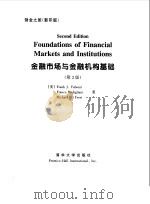《金融市场与金融机构基础 第2版》
| 作者 | (美)(F.J.法博齐)Frank J.Fabozzi著 编者 |
|---|---|
| 出版 | 北京:清华大学出版社 |
| 参考页数 | 651 |
| 出版时间 | 1999(求助前请核对) 目录预览 |
| ISBN号 | 7302034303 — 求助条款 |
| PDF编号 | 86641358(仅供预览,未存储实际文件) |
| 求助格式 | 扫描PDF(若分多册发行,每次仅能受理1册) |

Part Ⅰ INTRODUCTION1
Chapter 1 Introduction1
Chapter 1 Introduction1
Financial Assets2
Debt versus Equity Clairns 3·The Price of a Financial Asset and Risk 3· Financial Assets versus Ta4
Financial Markets6
Market Participants7
Globalization of Financial Markets8
Classification of Global Financial Markets9· Motivation for Using Foreign Markest and Euromarkets10
Derivative Markets11
Types of Derivatiue Instruments11·The Role of Derivative Instruments12
Summary13
Chapter 2 Financial Intermediaries and Financial Innovation17
Chapter 2 Financial Intermediaries and Financial Innovation17
Financial Institutions18
Role of Financial Intermediaries19
Maturity Intermediation20 ·Reducing Risk via Diversification20· Reducing the Cost of Contracting a21
Overview of Asset/Liability Management for Financial Institutions22
Nature of Liabilities 23 ·Liquidity Concerns 24· Regulations and Taxation25
Financial Innovation25
Categorization ofFinancial Innovation 25· Motivation for Financial Innovation26
Asset Securitization as aFinancial Innovation27
Benefits to Issuers 28· Benefits to Investors 29· Benefits to Borrowers 29· Implications of Secur30
Summary31
Chapter 3 The Role of the Government in Financial Markets34
Chapler 3 The Role of the Government in Financial Markets34
Purposes and Forms of Regulation35
Justification for Regulation 35 An Introduction to Forms of Regulation36
Regulation in the United States37
Regulation in Japan41
Regulation in Germany43
Regulation in the United Kingdom45
Regulatory Reform47
Summary48
Chapter 4 Depository Institutions:Activities and Characteristics52
Part ⅡDEPOSITORYINSTITUTIONS52
Chapter 4 Depository Institutions :Activities and Characteristics52
PartⅡ DEPOSITORY INSTITUNONS52
Asset/Liability Problem of Depository Institutions53
Interest Rate Risk 54·liquidity Concerns55
Commercial Banks56
Bank Services61·Bank Funding62·Regulation65
Savings and Loan Associations72
Assets72·Funding74·Regulation 74·The S L Crisis75
Credit Unions77
Savings Banks77
Summary78
Chapter 5 Central Banks and the Creation of Money84
Chapter 5 Central Banks and the Cretion of Money84
The Central Bank of the United States:The Federal Reserve System85
The Central Bank and Money Creation in the United States85
Instruments of Monerary Policy: Howthe Fed Influences the Supplyof Money86·Different Kinds of Money94
The Central Banks of Other Countries96
Germany 96·Japan97·United Kingdom97
Summary99
Chapter6 Monetary Policy102
Chapter6 Monetary Policy102
Monetary Policy in the United States103
Goals of Monetary Policy 103·Trade-Offs and Conflicts among Policies108·Goals and Types of Targets111
Goals and Targets of Monetary Policy in Other Economies116
Germany 116·Japan 117·United Kingdom118
Summary120
Part Ⅲ NON-DEPOSITORY FINANCIAL INTERMEDIARIES122
Chapter 7 Insurance Cornpanies122
Chapter 7 Insurance Companies122
Part Ⅲ NON-DEPOSITORY FINANCIAL INTERMEDIARIES122
Fundamental Characteristics of the Insurance Industry123
Insurance Policy and Premiums 123·Surplus and Reserves124·Determination of Profits 124·Government125
Life Insurance Companies126
Liabilities and Liability Risk127·Types of Policies127·Investments130
Propexty and Casualty Insurance Companies131
Nature of the Liabilites131·Inrestments132
Financial Trends in the International Insurance Industry133
Summary135
Bancassurance 133·Cross-Border Activities134·Pension Funds and Insurance Companies135
Chapter 8 Investment Companies139
Chapter 8 Investment Companies139
Types of Investment Companies140
Open-End Funds 140·Closed-End Funds141·Unit Trusts143
Structure and Expenses of a Fund144
Types of Funds by Investment Objective144
Economic Motivation for Funds146
Regulation of Funds147
Commercial Banks and Mutual Funds149
The Concept of a Family of Funds150
Industry Concentration151
Mutual Funds in Other Economies151
United Kingdom151·Germany153·Japan154
Summary156
Chapter 9 Pension Funds159
Chapter 9 Pension Funds159
Introduction to Pension Plans160
Types of Pension Plans161
Defined Contribution Plan161·Defined Benefit Plan 162·Hybrid Pension Plans162
Investments163
Regulation164
Managers of Pension Funds165
Pension Funds in Other Countries166
Germany166·United Kingdom 167·Japan168
Summary169
Appendix:Endowment Funds170
Chapter 10 Properties and Pricing of Financial Assets173
Chapter 10 Properties and Pricing of Financial Assets173
PartⅣ DETERMINANTS OF ASSET PRICES AND INTEREST RATES173
Part Ⅳ DETERMINANTS OF ASSET PRLCES AND INTEREST RATES173
Properties of Financial Assets174
Moneyness174·Divisibility and Denomination174·Reversibility174·Cash Flow 175·Term to Maturity176179
Principles of Pricing Financial Assets179
The Appropriate Discount Rate 180·Illustratiom 180·Price and Asset Properties181
Price Volatility of Financial Assets183
The Effect of Maturity 184·The Effect of the Coupon Rate 184·The Effect of the Level of Yields 186187
Summary192
Appendix:Review of Present Value194
Chapter 11 The Level and Structure of Interest Rates198
Chapter 11 The Level and Structure of Interest Rates198
The Theory of Interest Rates199
Fishers Classical Approach 199·The Loanable Funds Theory203·The Liquidity Preference Theory 204·C205
The Determinants of the Structure of Interest Rates208
Features of a Bond208·Yield on a Bond209·Tne Base Interest Rate212·The Risk Premium212
Summary217
Chapter 12 The Term Structure of Interest Rates223
Chapter 12 The Term Structure of In terest Rates223
The Yield Curve and the Term Structure224
Using the Yield Curve to Price a Bond 225·Constructing the Theoretical Spot Rate Curve226·Using Sp229
Forward Rates230
Other Forward Rates 233·Relationship between Spot Rates and Short-Term Forward Rates 234·Forward R235
Determinants of the Shape of the Term Structure235
Rule 144A238
The Pure Expectations Theory 236·The Liquidity Theory 239·The Preferred Habitat Theory 240·Market241
Summary242
Chapter 13 Risk/Return and Asset Pricing Models246
Chapter 13 Risk/Return and Asset Pricing Models246
Portfolio Theory247
Investment Retum247·Portfolio Risk 249·Diversification252·The Risk of Individual Securities254·E257
The Capital Asset Pricing Model258
Underlying Assumptions 260·Tests of the Capital Asset Pricing Model261
Multifactor CAPM263
Arbitrage Pricing Theory Model264
Empirical Evidence265
Summary267
PartⅤ ORGANIZATION AND STRUCTURE OF MARKETS271
Chapter 14 Primary Markets and the Underwritingof Securities271
Chapter 14 Primary Markets and the Underwriting of Securities271
PartⅤ ORGANIZATION AND STRUCTURE OF MARKETS271
The Traditional Process for Issuing New Securities272
Investment Bankers274
Regulation of the Primary Market275
Variations in the Underwriting Process277
Bought Deal 277·Auction Process278·Preemptive Rights Offering280
Private Placement of Securities282
Chapter 15 Secondary Markets288
Chapter 15 Secondary Markets288
Function of Secondary Markets289
Trading Locations290
Market Structures290
Perfect Markets291
Role of Brokers and Dealers in Real Markets292
Brokers 293·Dealers as Market Makers293
Market Efficiency295
Operational Efficiency295·Pricing Efficiency296
Summary296
Chapter 16 Treasury and Agency Securities Markets300
Part Ⅵ MARKETS FOR GOVERNMENT DEBT300
Part Ⅵ MARKETS FOR GOVERNMENT DEBT300
Treasury Securities301
Types of Treasury Securities301·The Primary Market 302·The Secondary Market306·Stripped Treasury313
Federal Agency Securities316
Government-Sponsored Enterprise Securities316
A Look at Non-U.S. Government Bond Markets319
Summary321
Instruments for Hedging Foreign Exchange Risk324
Chapter 17 Municipal Securities Markets325
Types and Features of Municipal Securities326
General Obligation Bonds326·Revenue Bonds327·Hybrid and Special Bond Securities327·Municipal Note329
Municipal Bond Ratings329
Tax Risks Associated with Investing in Municipal Securities331
The Primary Market332
The Secondary Market332
Yields on Municipal Bonds333
Regulation of the Municipal Securities Market334
Summary335
Part ⅦMARKETS FOR CORPORATE SECURITIES338
Chapter 18 Common Stock Markets in the United States338
Part Ⅶ MARKETS FOR CORPORATE SECURITIES338
Chapter 18 Common Stock Markets in the United States338
Chatacteristics of Common Stock339
Trading Locations339
Srock Exchanges 340·Over-the-Counter Market341·Indeprndent Electronic Trading Systems 341·Trading349
Trading Arrangements for Insritutional Investors350
Block Trades351·Program Trades352
Stock Market Indicators353
Pricing Efficiency of the Stock Market356
Forms of Efficiency 356·Implications for Investing in Common Stock357
Stock Market Crash of 1987358
Summary360
Chapter 19 Stock Markets around the World365
Chapter 17 Municipal Securities Markets365
Chapter19 Stock Markets around the World365
National Stock Markets366
Multiple Listings on National Markets 366·Global Diversification:Correlation of World Equity Market376
Euroequity Lssues378
Global Depository Receipts380
Summary381
Summary384
Chapter 20 Markets for Corporate Senior Instruments:I385
Chapter 20 Markets for Corporate Senior Instruments:I385
Credit Risk and the Role of Rating Companies386
Commercial Paper387
Issuers of Commercial Paper388·Directly Placed versus Dealer-Placed Paper389·Non-US Commerical Pap390
Medium-Term Notes391
Size of Market and Issuers391·The Primary Market*392·Structured MTNs394
Euronotes394
Bank Loans395
Syndicated Bank Loans396·Lease Financing397
Summary398
Chapter 21 Corporate Senior Instruments:II401
Chapter 21 Corporate Senior Instruments:II401
Corporate Bonds402
Basic Features of a Corporate Bond Issue402·Bonds with Special Features 405·Corporate Bond Credit413
PrefernedStock415
Adjustable-Rate Preferred Stock416·Auction and Remarketed Preferred Stock417
Bankruptcy and Creditor Rights418
Summary419
Chapter 22 The Markets for Bank Obligations423
Chapter 22 The Markets for Bank Obligations423
Large-Denomination Negotiable CDs424
Types of Banks Operating in theUnited States424
CD Issuers 425·Yields on CDs426
Federal Funds427
Federal Funds Rate428·Market for Federal Funds428
Bankers Acceptances429
Illustration of the Creation of a Bankers Acceptance 430·Accepting Banks431·Dealers 431·Credit Ri432
Summary432
PartⅧ MORTGAGE AND SECURITIZED ASSET MARKETS435
Chaptetr 23 The Mortgage Market435
Chapter 23 The Mortgage Market435
Part Ⅷ MORTGAGE AND SECURITIZED ASSET MARKETS435
Whta Is a Mortgage?436
Mortgage Origination436
The Mortgage Originataion Process437·The Risks Associated with Mortgage Origination439
Types of Mortgage Design440
Fixed-Rate,Level-Payment,Fully Amortized Mortgages 441·Adjustable-Rate Mortgages444·Other Mortgage446
Investment Risks450
Credit Risk 450·Liquidity Risk450·Price Risk 450·Prepayments and Cash Flow Uncertainty450
Summary451
Chapter 24 Mortgage-Backed Securities Market454
Chapter 24 Mortgage-Backed Securities Market454
Developrnent of the Secondary Mortgage Market455
Foundations of the Mortgage Market 455·Securitization of Mortgages456
Mortgage Pass-Through Securities457
Cash Flow Characteristics457·Issuers of Mortgage Pass-Through Securities 457·Government National M471
Collateralized Mortgage Obligations472
Sequential-Pay CMOs473·Accrual Bonds 478·Planned Amortization Class Tranches479
Stripped Mortgage-Backed Securities483
Yields on Mortgage-Backed Securities484
Summary485
Chapter 25 Asset-Backed Securities Market488
Chapter 25 Asset-Backed Securities Market488
Asset-Backed Securities Issuance489
Cash Flow of Asset-Backed Securities491
Autornobile-LoanBacked Securities493·Credit Card Receivable Asset -Backed Securities493·Home Equit495
Credit Risk495
Summary496
Chapter 26 Financial Futures Markets499
Part Ⅸ MARKETS FOR DERIVATIVE SECURITIES499
Part Ⅸ MARKETS FOR DERLVATIVE SECURITIES499
Chapter 26 Financial Futures Markets499
Futures Contracts500
Futures versus Forward Contracts506
Liquidating a Position501·The Role of the Clearinghouse502·Margin Requirements502·Leveraging Aspe506
The Role of Futures in Financial Markets507
U.S. Financial Futures Markets509
Stock Index Futures Markets 509·Interest Rate Futures Markets510
The GAO Study on Financial Derivatives514
Financial Futures Markets in Other Countries515
Japanese Stock Index Futures516·Japanese Interest Rate Futures516
Forward Rate Agreements517
Summary519
Chapter 27 Options Markets523
Chapter 27 Options Markets523
Options Contracts524
Risk and Return Characteristics of Options526
Differences between Options and Futures Contracts526
Buying Call Options 527·Writing (Selling)Call Options530·Buying Put Options531·Writing (Sellimg)P534
Economic Role of the Option Markets535
U.S.Options Markets537
Stock Options 537·Stock Index Options539·Interest Rate Options542·Exotic Options542
Options Markets Outside the Untied States543
Futures Options544
Mechanics of Trading Futures Options 544·Reasons for Popularity of Futures Options546
Summary546
Chapter 28 Pricing of Futures and Options Contracts550
Chapter 28 Pricing of Futures and Options Contracts550
Pricing of Futures Contracts551
Theoretical Futures Price Based on Arbitrage Model553·Price Convergence at the Delicery Date 556·A556
Pricing of Options559
Basic Components of the Option Price559·Put-CallParity Relationship560·Factors That Influence the568
Summary570
Chapter 29 The Applications of Futures and Options Contracts574
Chapter 29 The Applications of Futures and Options Contracts574
Applications of Futures Contracts575
Stock Index Futures575·Interest Rate Futures578
Applications of Options Contracts580
Stock Options and Stock Index Options 580·Interest Rate Options581
Summary582
Appendix:General Principles of Hedging with Futures583
Chapter 30 Interest Rate Swap and Interest Rate Agreement Market590
Chapter 30 Interest Rate Swap and Interest Rate Agreement Market590
Interest Rate Swaps591
Risk/Return Characteristics of a Swap591·Interpreting a Swap Position 592·Applications595·Reasons608
Interest Rate Agreements610
Risk/Return Characteristics610·Applications612
Summary613
Chapter 31 TheMarket for Foreign Exchange Rate Risk Control Instruments617
Chapter 31 The Market for Foreign Exchange Rate Risk Control Instruments617
Foreign Exchange Rates618
Exchange Rate Quotation Conventions618·Foreign Exchange Risk620
Spot Market621
Cross Rates622·Dealers622·The European Currency Unit623
Currency Forward Contracts624·Currency Future Contracts630·Currency Option Contracts630·Currency631
Summary635
Index639
Index639
1999《金融市场与金融机构基础 第2版》由于是年代较久的资料都绝版了,几乎不可能购买到实物。如果大家为了学习确实需要,可向博主求助其电子版PDF文件(由(美)(F.J.法博齐)Frank J.Fabozzi著 1999 北京:清华大学出版社 出版的版本) 。对合法合规的求助,我会当即受理并将下载地址发送给你。
高度相关资料
-

- 金融市场学
- 1999 成都:四川人民出版社
-

- 金融体制改革理论与实践
- 1988 北京:北京大学出版社
-

- 俄语语法修辞
- 1981 上海:上海译文出版社
-

- 金融市场论
- 1988 北京:经济科学出版社
-

- 金融市场
- 1993 北京:北京语言学院出版社
-

- 金融市场基础知识
- 1995 成都:西南财经大学出版社
-

- 金融信托与金融市场
- 1990 天津:天津科学技术出版社
-

- 金融市场
- 1994 长春:吉林大学出版社
-

- 金融市场学
- 1997 上海:上海科学技术文献出版社
-

- 金融市场
- 1993 成都:西南财经大学出版社
-

- 金融基础
- 1999 北京:高等教育出版社
-

- 金融市场学
- 1999 北京:高等教育出版社
-

- 金融市场
- 1995 西安:陕西人民出版社
-

- 金融市场
- 1987 北京:中国金融出版社
-

- 金融市场
- 1968 中国经济月刊社
提示:百度云已更名为百度网盘(百度盘),天翼云盘、微盘下载地址……暂未提供。➥ PDF文字可复制化或转WORD